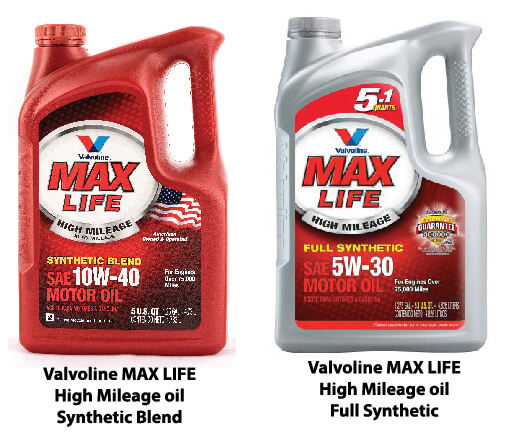High mileage oil versus conventional oil
Should you use high mileage oil versus conventional oil
What is high mileage oil?
High mileage oil contains more of the additives an older engine needs. I have interview the tribologists at Valvoline and can speak to what Valvoline high mileage oil contains. But I am not privy to what other high mileage oil brands contain.
Specifically, high mileage oil contains more of these additives
Valvoline High Mileage oil contains more detergent
Older engines generally have more blowby and that blowby contains more fuel and exhaust contaminants that can form carbon deposits and sludge in the engine. The additional detergent helps keep an older engine cleaner.
More Dispersant additives
Dispersant additives keep particulates in suspension in the oil so they can be filtered out by the oil filter. Since there’s more soot and contaminants in the blowby of older engines, the oil need a bit more dispersant.
Valvoline high mileage oil contains more Anti-wear additives
Older engines often have more wear in critical bearing clearances. That additional wear can cause oil pressure drops that cause even more metal to metal contact. That can use up the anti-wear additives in regular oil. So HM oil contains more anti-wear additives to compensate for the loss.
More anti-corrosion additives
More blowby means more fuel and water in the oil, which can cause more corrosion additive depletion in regular oil. High mileage oil makes up for that by adding in more anti-corrosion additives.
More acid neutralizer additive
Acids form in crankcase oil when combustion gasses dissolve in the oil. Water is a byproduct of combustion and when it enters the crankcase, water activates the acids by hydrolyzing them to form Formic and Nitric acid, which causes corrosion.
Additional Seal conditioner in high mileage oil
All oil contains a small amount of seal conditioner. But high mileage oil contains more to soften hardened seals and reduce leaks.
More viscosity index improver (VII) additives in high mileage oil
Older engines tend to generate more oil shear and oil shear permanently damages the viscosity index improver used to create multi-viscosity oils, thereby reducing overall viscosity. High mileage oil contains more VII to make up for the VII loss in regular oil.
Older engines produce more blow-by gasses and that creates all kinds of additional problems that can be reduced by high mileage oil
All engines (even new ones) have some amount of blow-by; combustion gas that squeezes past the piston rings and into the crankcase. Because high mileage engines have more cylinder and ring wear, they also more blow-by.
Blow-by gasses contain unburned fuel, water and soot. The added dispersant keeps the soot in suspension so it can be filtered out by the oil filter, lessening the chances of sludge formation. The added detergent and anti-corrosion additives keep everything cleaner. The added viscosity improvers help keep the oil at the proper viscosity.

High mileage oil is available as a synthetic blend or full synthetic. Full synthetic high mileage oil provides the best protection for older engines
Is high mileage oil worth it?
The HM oil manufacturers recommend using HM oil at 75K miles. That may be a bit early. But if your vehicle has over 150K miles, you should seriously consider using HM oil.HM oil is available in conventional and synthetic formulations. If your vehicle requires synthetic oil, simply choose a synthetic HM oil with the recommended viscosity for your engine.
Check your dipstick more often as your engine ages
Older engines tend to burn and leak more oil. Running your engine when it’s even a quart low can dramatically reduce the life of the remaining oil. If you’re accustomed to changing your oil every 7,500 miles but run your engine a quart low, you could wear out the critical additives in your oil as soon as 5,000 miles.
Read this frightening statistic from oil industry publication Lubes and Greases
“If an engine becomes starved for oil, it can suffer premature wear and even failure. Fast oil change outlets have reported servicing vehicles with upwards of 10,000 miles since the last oil change that are two to three quarts low on oil. Oil that is used significantly beyond its prescribed drain interval can become heavily oxidized and too viscous to drain from the engine, let alone lubricate it effectively.”
Lubes and Greases, March 2017
© 2012 Rick Muscoplat
Posted on by Rick Muscoplat
